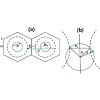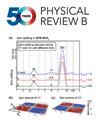具有幂律电阻率的非费米液体模型:起源并不奇怪的奇怪金属
IF 3.7
2区 物理与天体物理
Q1 Physics and Astronomy
引用次数: 0
摘要
我们构建的模型显示,电阻率在温度 T 上呈幂律变化,Tα 下降到最低温度。由于我们假定不存在无序,且动量弛豫是由 umklapp 散射引起的,因此不存在残余电阻率。我们的模型包括一个量子自旋液态,它有一个自旋子费米面和一个由掺杂空穴组成的空穴费米面。关键要素是一组奇异的 2kF 模式,它们生活在动量空间的一个环上。根据参数的不同,α 可能是统一的(奇异金属),也可能更小。该模型可能适用于掺杂的有机化合物,该化合物已被发现表现出线性 T 电阻率。我们的结论是,从一个并不奇怪的模型出发,是有可能获得奇异金属行为的。本文章由计算机程序翻译,如有差异,请以英文原文为准。

Model of a non-Fermi liquid with power-law resistivity: Strange metal with a not-so-strange origin
We construct a model that exhibits resistivity going as a power law in temperature , as down to the lowest temperature. There is no residual resistivity because we assume the absence of disorder and momentum relaxation is due to umklapp scattering. Our model consists of a quantum spin liquid state with a spinon Fermi surface and a hole Fermi surface made out of doped holes. The key ingredient is a set of singular modes living on a ring in momentum space. Depending on parameters, may be unity (strange metal) or even smaller. The model may be applicable to a doped organic compound, which has been found to exhibit linear resistivity. We conclude that it is possible to obtain strange metal behavior starting with a model that is not so strange.
求助全文
通过发布文献求助,成功后即可免费获取论文全文。
去求助
来源期刊

Physical Review B
物理-物理:凝聚态物理
CiteScore
6.70
自引率
32.40%
发文量
0
审稿时长
3.0 months
期刊介绍:
Physical Review B (PRB) is the world’s largest dedicated physics journal, publishing approximately 100 new, high-quality papers each week. The most highly cited journal in condensed matter physics, PRB provides outstanding depth and breadth of coverage, combined with unrivaled context and background for ongoing research by scientists worldwide.
PRB covers the full range of condensed matter, materials physics, and related subfields, including:
-Structure and phase transitions
-Ferroelectrics and multiferroics
-Disordered systems and alloys
-Magnetism
-Superconductivity
-Electronic structure, photonics, and metamaterials
-Semiconductors and mesoscopic systems
-Surfaces, nanoscience, and two-dimensional materials
-Topological states of matter
 求助内容:
求助内容: 应助结果提醒方式:
应助结果提醒方式:


